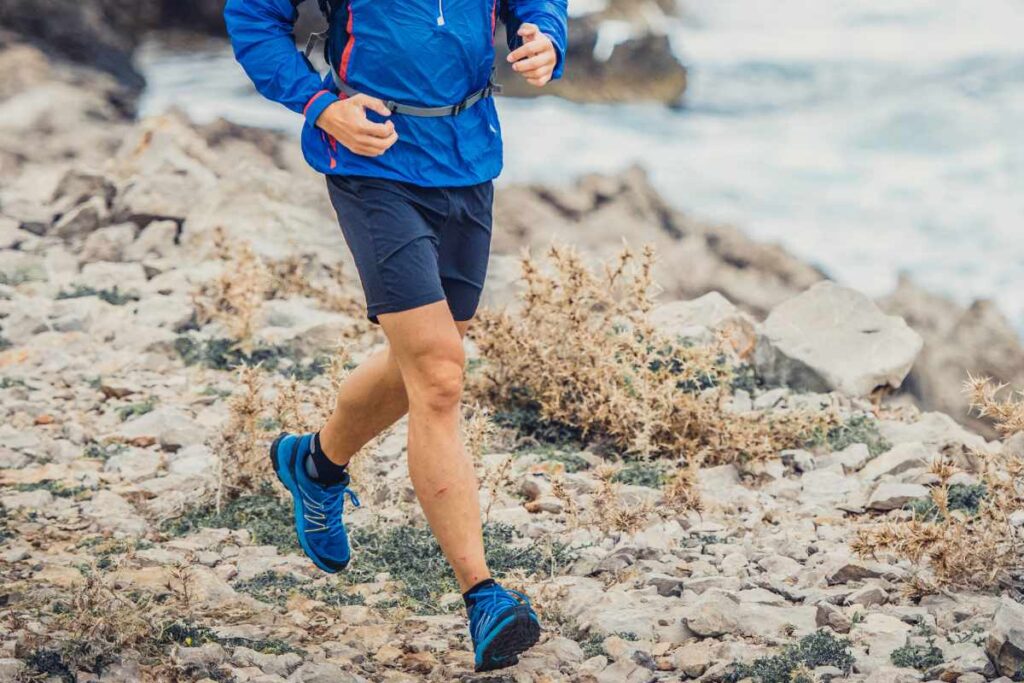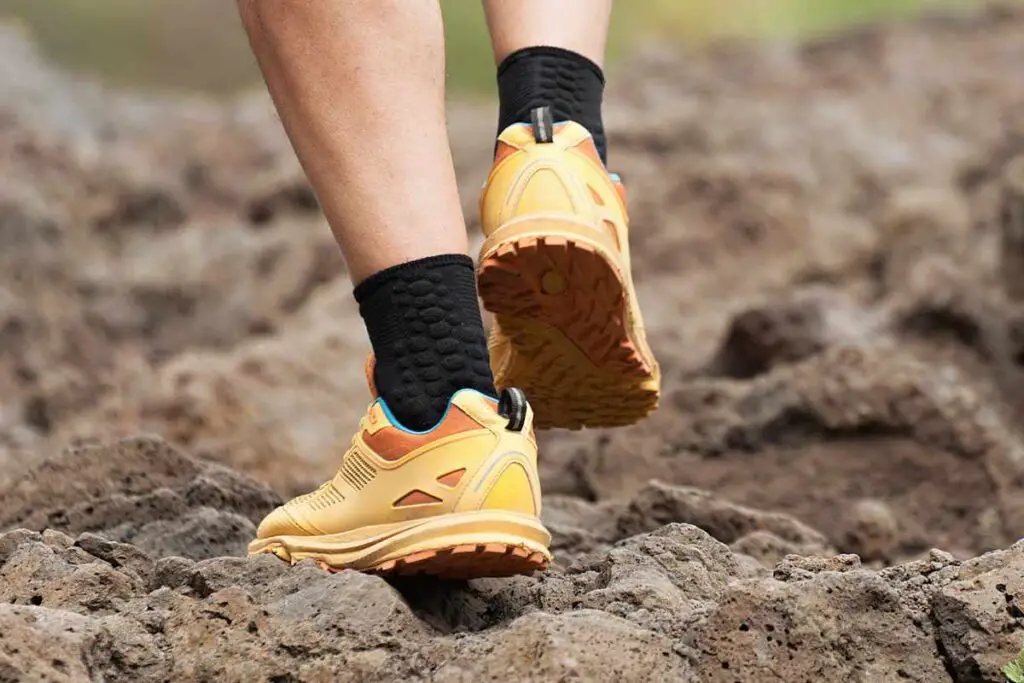When setting out on a hiking trail, choosing the right footwear is crucial for your comfort and safety. You might wonder if your running shoes can double as hiking shoes.
The good news is that many hikers successfully use running shoes on trails. Running shoes are typically comfortable and lightweight, making them appealing for long treks.
Especially in the case of trail running shoes, they often offer adequate traction and may have additional features for durability and support that are desirable on rugged paths.
Some Running Shoes Are Not Good for Hiking

Not all running shoes are suitable for every hiking scenario.
The trails you choose to explore play a significant role in determining if your running shoes will suffice.
For well-maintained paths or short day hikes, running shoes could be enough. But for more demanding terrain, shoes specifically designed for hiking offer additional protection against sharp rocks, roots, and uneven ground.
They also often provide better ankle support and are designed to withstand the wear and tear of trekking through tougher landscapes.
It’s important to consider the trade-offs when opting for running shoes on your hiking journeys.
While the lightweight design and breathability are a boon on dry and even trails, they may fall short in providing the stability and weather resistance that hiking boots offer.
Trail running shoes strike a middle ground, with features that cater to both runner and hiker needs, such as quick-drying materials, enhanced grip, and more rugged construction than typical running shoes.
Your choice ultimately depends on the type of hike you’re planning and your personal preference for comfort versus durability.

Understanding Footwear for Hiking
When preparing for a hike, your footwear choice can significantly impact your experience.
The intersection of comfort, durability, and suitability to terrain dictates your decision between traditional hiking shoes and alternatives like running shoes.
Advantages of Running Shoes for Hiking
Running shoes, particularly trail runners, offer distinct advantages for hiking:
- Comfort: They are designed to cushion your feet on hard surfaces, which can make them a comfortable option for long hikes.
- Lightweight: Running shoes are typically lighter than hiking boots, reducing leg fatigue, which helps you maintain a quicker pace for longer periods.
Drawbacks of Running Shoes as Hiking Footwear
However, there are also notable drawbacks when choosing running shoes for hiking:
- Not Durable: Running shoes may not withstand the harsh conditions of some trails, lacking the robust construction of a hiking shoe.
- Limited Protection: They often provide less support and protection against rugged terrain, which can increase the risk of injuries such as ankle twists.
- THIS MEN'S SHOE IS FOR: Trail Runners who want to explore and feel protected on changing terrain. This shoe is made to adapt quickly so runners stay comfortable and stable. Predecessor: Cascadia 15
- SUPPORT IN ALL TERRAIN: Release grooves in the midsole allow for enhanced adaptability on rough terrain, while the Ballistic Rock Shield now includes vertical grooves to provide side-to-side adaptability. Updated construction allows the shoe to adapt, flex, and protect the foot in all terrains.
- CUSHION AND COMFORT: New DNA LOFT v2 Technology provides 10% softer and 20% lighter cushioning than previous models. New 2mm of foam in the midsole gives added comfort.
- HIGH PERFORMANCE IN ALL ENVIRONMENTS: TrailTack rubber outsole provides wet-dry traction, drainage ports allow water to escape quickly, and gusset keeps out sand and small debris, allowing for high performance on all trails and conditions.
Key Features of Hiking and Running Shoes
In choosing between hiking and running shoes, you must consider their key features such as traction, support, and materials which directly impact performance and comfort during outdoor activities.
Comparing Traction and Grip
- Trail Shoes: Typically designed with deeper lugs and more aggressive tread patterns to offer superior traction on dirt, mud, and uneven surfaces.
- Road Running Shoes: Have flatter soles with less pronounced tread patterns, prioritizing smoothness on pavement, which may be less effective on rugged trails.
- Hiking Boots: Generally feature the most aggressive tread patterns for maximum grip on a variety of surfaces including steep, slippery, or loose terrain.
Fit and Support
- Hiking Boots: Provide firm ankle support to protect against sprains and have stiff midsoles for stability on uneven ground.
- Trail Shoes: Offer a balance of support and comfort with some flexibility to adjust to the terrain while maintaining a lightweight design.
- Road Running Shoes: Prioritize a snug fit that contours to the foot with greater flexibility for ease of movement, which might not provide enough support for challenging hikes.
Materials and Durability
- Hiking Boots: Often made with durable materials like leather or advanced synthetics, designed to withstand abrasion and provide long-lasting protection.
- Trail Shoes: Constructed with a blend of durability and breathability, featuring reinforced areas to resist wear while allowing air flow.
- Road Running Shoes: Focus on breathability and lightweight, often incorporating mesh materials that offer less protection from elements compared to trail shoes or hiking boots.
Selecting Shoes for Different Terrains

Your choice of footwear can significantly impact your hiking experience, depending on the terrain.
It is essential to consider the tread patterns and other physical features of shoes designed for different trail types.
Trail Runners for Established Trails
On established trails, you can often opt for trail runners, which provide ample traction and are engineered with adequate tread patterns to handle well-maintained paths.
Look for shoes with lugs on the outsole, as these can enhance grip on mixed surfaces and aid in shedding debris to prevent slipping.
- Tread: Moderately spaced lugs for balanced grip
- Rock Plate: Optional but beneficial for added protection
Read later 🏃 Hiking vs Running: Comparing Benefits and Challenges
Choosing Footwear for Rugged Trails
For more rugged trails characterized by loose dirt, mud, gravel, roots, and rocky outcrops, you’ll need shoes designed to tackle the increased demands.
Durability and protection are paramount. Shoes for these conditions often come equipped with a rock plate to shield your feet from sharp impacts and have robust upper materials resistant to abrasion.
- Tread: Deep, aggressive lugs for superior traction
- Rock Plate: Essential to protect against rocks and roots
Selecting the correct shoes can make a substantial difference in your hiking performance and enjoyment, so it’s worth investing time to find the right fit for the terrain ahead.

The Impact of Weather and Climate on Choice
When considering running shoes for hiking, the specific weather and climate conditions you’ll encounter are pivotal factors in determining your ideal footwear.
Waterproofing can either be a boon or a detriment, depending on the environment.
Waterproof Versus Non-Waterproof Shoes
Waterproof Shoes
Ideal for cold and wet conditions, shoes with a waterproof membrane, such as Gore-Tex, offer protection from moisture.
However, in warm climates, they may cause your feet to sweat excessively due to lesser breathability.
Pros:
- Keeps feet dry in wet conditions
- Offers additional warmth in cold weather
Cons:
- Less breathability can lead to sweaty feet
- May retain water if fully submerged
Non-Waterproof Shoes
These shoes are typically more breathable and better suited for hot or dry climates. They allow for better moisture management within the shoe, ensuring comfort on long hikes.
Pros:
- Enhanced breathability keeps feet cooler
- Quicker drying when they do get wet
Cons:
- Feet may get wet in rainy or wet trail conditions
- Less protection in cold weather
Selecting between waterproof and non-waterproof running shoes for hiking hinges on the season and weather you expect to encounter.
Heavier, waterproof footwear provides warmth and water protection but may not be necessary or comfortable in a drier, more temperate season.
Conversely, a breathable, non-waterproof shoe can enhance your comfort in warmer, drier climates but may leave you vulnerable to the elements when conditions are not in your favor.
Top Shoe Models for Hiking and Running
When you’re tackling the trails, whether through running or hiking, choosing the right shoe is crucial.

For optimum performance and comfort, certain models stand out due to their dual-running-and-hiking capabilities.
- Altra Lone Peak 7: This shoe is known for comfort, with a design that accommodates a natural foot position. It offers a good grip and is designed to handle both trails and mixed terrains.
- Hoka One One Speedgoat 5: Recognized for exceptional traction, the Speedgoat 5 is a trail shoe that provides cushioning and support, making it suitable for both running and hiking.
- Salomon: Salomon’s range often includes models with good stability and grip. Their shoes are tailored for technical trails and offer durability that can withstand both hiking and running demands.
- La Sportiva: Offering models like the Raptor, which is crafted for the trails, La Sportiva shoes feature soles with grippy rubber and edged treads for better traction on uneven grounds.
- Brooks Cascadia 16: Brooks offers reliable trail shoes like the Cascadia 16 with notable features to support your feet during both trail running and hiking.
- Altra Lone Peak 6: This model maintains the reputation of the Lone Peak line for a balance of comfort and performance on diverse terrains.
- Merrell Moab 3: A versatile option, the Moab 3 from Merrell is built to be durable and comfortable, suitable for both day hikes and trail running.
- FOOTSHAPE: Our signature FootShape comfort gives your feet more space to sit naturally and is designed to address biological differences in men's and women's feet.
- ALTRA EGO: Our original Altra EGO foam is designed to harmonize the balance between responsiveness and comfort.
- BALANCED CUSHIONING: Our Balanced Cushioning platform positions your heel and forefoot at an equal distance from the ground, encouraging better alignment and form.
- MAXTRAC: Our grippy MaxTrac outsole provides the perfect combination of grip, traction, and durability on all types of terrain.
When selecting a shoe, consider the factors most important to your experience: cushioning, traction, and durability.
Each brand and model brings unique benefits, so align your choice with the specific demands of your trail activities.








